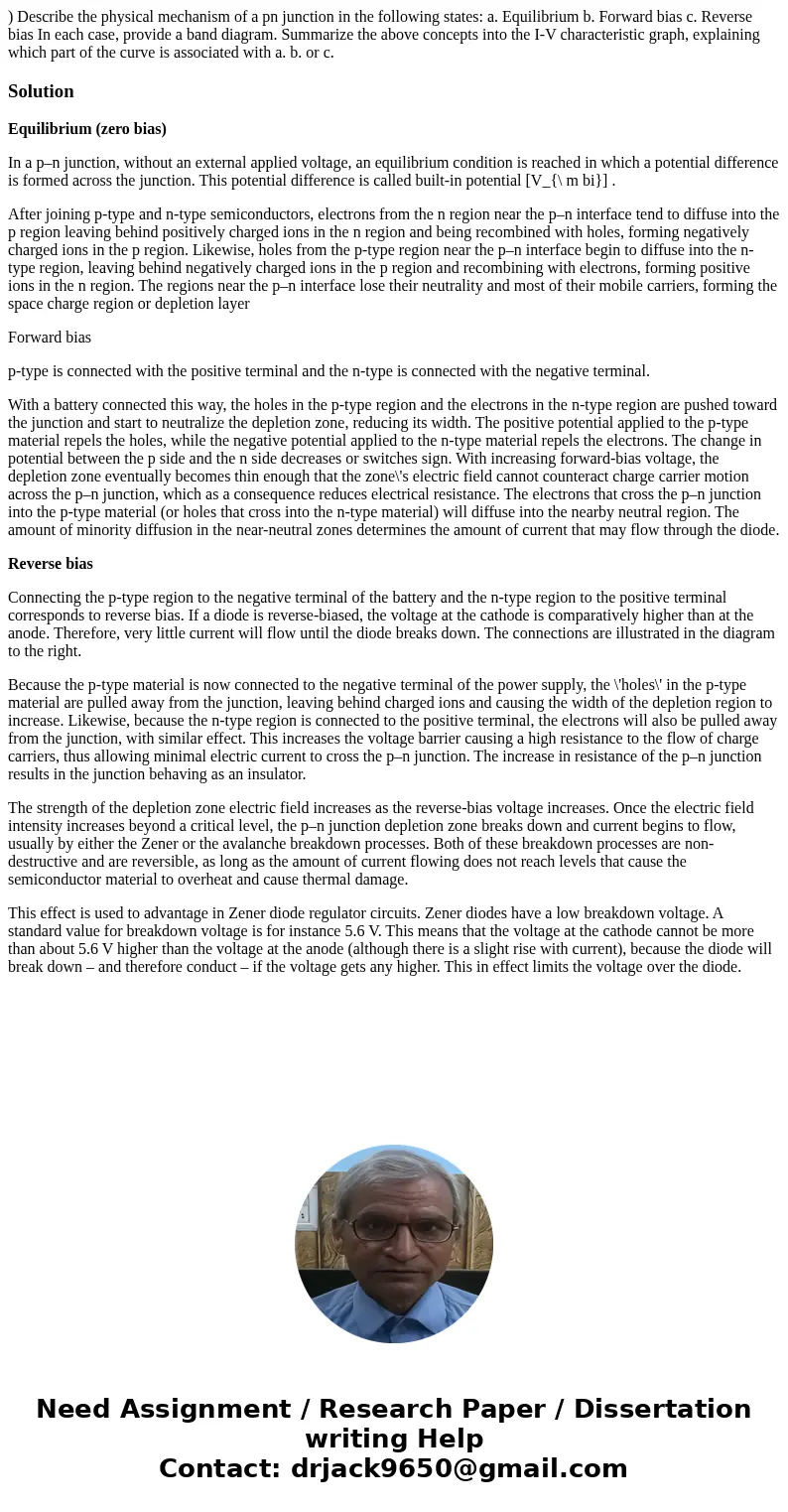Describe the physical mechanism of a pn junction in the fol
) Describe the physical mechanism of a pn junction in the following states: a. Equilibrium b. Forward bias c. Reverse bias In each case, provide a band diagram. Summarize the above concepts into the I-V characteristic graph, explaining which part of the curve is associated with a. b. or c.
Solution
Equilibrium (zero bias)
In a p–n junction, without an external applied voltage, an equilibrium condition is reached in which a potential difference is formed across the junction. This potential difference is called built-in potential [V_{\ m bi}] .
After joining p-type and n-type semiconductors, electrons from the n region near the p–n interface tend to diffuse into the p region leaving behind positively charged ions in the n region and being recombined with holes, forming negatively charged ions in the p region. Likewise, holes from the p-type region near the p–n interface begin to diffuse into the n-type region, leaving behind negatively charged ions in the p region and recombining with electrons, forming positive ions in the n region. The regions near the p–n interface lose their neutrality and most of their mobile carriers, forming the space charge region or depletion layer
Forward bias
p-type is connected with the positive terminal and the n-type is connected with the negative terminal.
With a battery connected this way, the holes in the p-type region and the electrons in the n-type region are pushed toward the junction and start to neutralize the depletion zone, reducing its width. The positive potential applied to the p-type material repels the holes, while the negative potential applied to the n-type material repels the electrons. The change in potential between the p side and the n side decreases or switches sign. With increasing forward-bias voltage, the depletion zone eventually becomes thin enough that the zone\'s electric field cannot counteract charge carrier motion across the p–n junction, which as a consequence reduces electrical resistance. The electrons that cross the p–n junction into the p-type material (or holes that cross into the n-type material) will diffuse into the nearby neutral region. The amount of minority diffusion in the near-neutral zones determines the amount of current that may flow through the diode.
Reverse bias
Connecting the p-type region to the negative terminal of the battery and the n-type region to the positive terminal corresponds to reverse bias. If a diode is reverse-biased, the voltage at the cathode is comparatively higher than at the anode. Therefore, very little current will flow until the diode breaks down. The connections are illustrated in the diagram to the right.
Because the p-type material is now connected to the negative terminal of the power supply, the \'holes\' in the p-type material are pulled away from the junction, leaving behind charged ions and causing the width of the depletion region to increase. Likewise, because the n-type region is connected to the positive terminal, the electrons will also be pulled away from the junction, with similar effect. This increases the voltage barrier causing a high resistance to the flow of charge carriers, thus allowing minimal electric current to cross the p–n junction. The increase in resistance of the p–n junction results in the junction behaving as an insulator.
The strength of the depletion zone electric field increases as the reverse-bias voltage increases. Once the electric field intensity increases beyond a critical level, the p–n junction depletion zone breaks down and current begins to flow, usually by either the Zener or the avalanche breakdown processes. Both of these breakdown processes are non-destructive and are reversible, as long as the amount of current flowing does not reach levels that cause the semiconductor material to overheat and cause thermal damage.
This effect is used to advantage in Zener diode regulator circuits. Zener diodes have a low breakdown voltage. A standard value for breakdown voltage is for instance 5.6 V. This means that the voltage at the cathode cannot be more than about 5.6 V higher than the voltage at the anode (although there is a slight rise with current), because the diode will break down – and therefore conduct – if the voltage gets any higher. This in effect limits the voltage over the diode.

 Homework Sourse
Homework Sourse